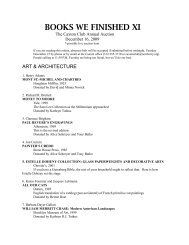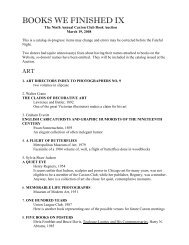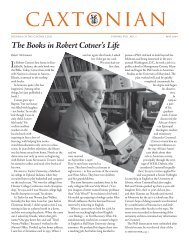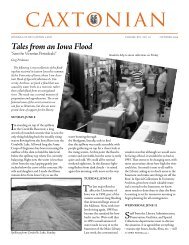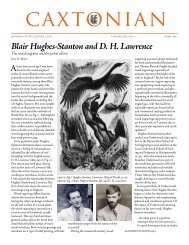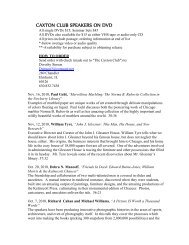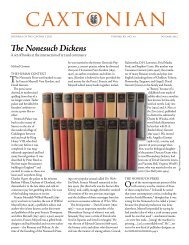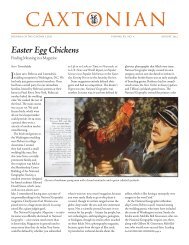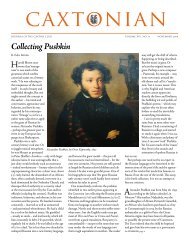July - The Caxton Club
July - The Caxton Club
July - The Caxton Club
You also want an ePaper? Increase the reach of your titles
YUMPU automatically turns print PDFs into web optimized ePapers that Google loves.
Mr. Croft is mentioned in the second case.<br />
This may be the source of the name Mycroft,<br />
Holmes’ brother. <strong>The</strong>re are numerous coincidences<br />
involving these names cited in Conan<br />
Doyle’s experience. I will take all the elements<br />
discussed and set up my own hypothesis: this<br />
time associating a Bell with a Watson – Alexander<br />
Graham Bell and Thomas A. Watson.<br />
<strong>The</strong> first telephone conversation, in 1876, was:<br />
“Ahoy, Watson! Can you hear me” Conan<br />
Doyle would certainly have heard about this<br />
well before 1887, when the first manuscript, A<br />
Study in Scarlet, was published. To place all<br />
this into an all-encompassing package, the<br />
Yale professor previously mentioned, who<br />
emulated Joseph Bell, coincidentally married<br />
Thomas A. Watson’s daughter!<br />
It has been proposed by one Sherlockian,<br />
Dr. Carl L. Heifetz, that Sherlock Holmes’<br />
obfuscation concerning his origins, early<br />
life and activities, his reticence to be photographed<br />
or appear in newspapers, or to<br />
acknowledge his crime investigations, was<br />
due to his undercover activities for the British<br />
government. 221B Baker Street may not have<br />
been his real address because of his undercover<br />
activities. Similarly, Holmes’ reluctance<br />
to have Watson publish his cases (only 60 out<br />
of over 1000) suggests a secrecy that cannot<br />
be attributable to modesty [Holmes himself<br />
admitted that modesty was of no importance].<br />
<strong>The</strong> basis for this hypothesis was Holmes’ participation<br />
in three cases involving the British<br />
government and during which stolen documents<br />
were retrieved, “<strong>The</strong> Naval Treaty,” the<br />
“Bruce-Partington Plans,” and “<strong>The</strong> Second<br />
Stain.” Heifetz noted that Holmes’ service as<br />
an undercover agent was fully acknowledged<br />
in His Last Bow.<br />
Other evidence that Holmes participated in<br />
government activities includes his undercover<br />
work as a Norwegian explorer to the Khalifa<br />
of Khartoum, with information delivered to<br />
the British foreign office. His brother, Mycroft,<br />
from his perch in the Diogenes <strong>Club</strong>, was a<br />
government auditor, and the ultimate resource<br />
for resolution of government issues. According<br />
to Holmes, “He actually was the British<br />
government.” <strong>The</strong> apocrypha (Holmes stories<br />
after Conan Doyle’s death) insist that Mycroft<br />
Holmes was the founder of the British secret<br />
services, MI5 and MI6 in 1909, and that the<br />
“M” stands for Mycroft!<br />
Let us evaluate the mysterious pull of the<br />
Sherlock Holmes Canon using as an<br />
example “<strong>The</strong> Adventure of the Golden Pince-<br />
Nez.” <strong>The</strong> outline of the story is as follows:<br />
Yard inspector to assist in investigating the<br />
murder of a male secretary of an invalid<br />
professor. Through the clue of a pince-nez,<br />
retrieved from the murdered secretary’s hand,<br />
Holmes solves the mystery by determining<br />
that the murderer could not have left the<br />
house. <strong>The</strong> murderer was ultimately found<br />
hiding in the professor’s closet. She was the<br />
long-estranged wife of the professor, and had<br />
killed the secretary when he discovered her<br />
trying to retrieve a document from the study.<br />
Looking closer, readers familiar with Sherlock<br />
Holmes find elements in common<br />
with other stories. Watson, the usual narrator,<br />
lists cases with intriguing names (“the repulsive<br />
story of the red leech,” e.g.) that are not<br />
ready for publication, and indeed, never will<br />
be, and recalls that Holmes achieved another<br />
honor from a foreign government for solving<br />
an international crime.<br />
A second common element is weather. It<br />
was a “wild, tempestuous night,” with howling<br />
winds, that draws a visitor to Baker Street<br />
only because of an extraordinarily pressing<br />
matter.<br />
Holmes, as usual, is involved in one of many<br />
side interests, deciphering an original inscription<br />
in a medieval manuscript, occupying him<br />
all day. Watson is by no means idle himself,<br />
deeply absorbed in a surgical tract. Holmes is<br />
also shown to be interested in many special<br />
areas, including: de Lassus motets, wines, warships,<br />
medieval pottery, and the history and<br />
playing of violins.<br />
<strong>The</strong> introduction also provides us with an<br />
example of Holmes’ characteristic courtesy.<br />
When Inspector Stanley Hopkins appears,<br />
Holmes, handing him a cigar, bids him have<br />
a warm drink. However, there is clearly an<br />
acknowledgement of class. Holmes is a gentleman.<br />
Hopkins is, in a sense, a tradesman. He<br />
is addressed as “Hopkins,” but it is always “Mr.<br />
Holmes.”<br />
Continuing the formula, the crime is summarized<br />
comprehensively but succinctly, in<br />
this case by the Inspector, and the points of<br />
the mystery delineated: the last ambiguous<br />
words of the secretary, “<strong>The</strong> professor, it was<br />
she”; the golden pince-nez in the murdered<br />
secretary’s hand, with lenses too close even<br />
for thin-faced Holmes; the murder weapon,<br />
and a knife from a desk in the study. Naturally,<br />
the Inspector is stymied; he thinks he noted<br />
everything in the details of the inspection.<br />
“Except Sherlock Holmes,” says Holmes, with<br />
a bitter smile. At another point, he says that<br />
with all his investigation, Hopkins “had made<br />
certain that [he] had made certain of nothing.”<br />
Although Holmes is always courteous, there<br />
is always a barb to indicate his intellectual<br />
superiority. This infallibility may be one of his<br />
attractions to readers.<br />
Holmes concludes that the murderer is a<br />
well-dressed woman with a thick nose, closelyset<br />
eyes, and a peering expression, who has<br />
seen an optician twice during the past month.<br />
He explains the reasoning behind his deductions,<br />
based entirely upon his observation of<br />
the pair of glasses found by the Inspector. <strong>The</strong><br />
reader is provided with a dazzling deduction<br />
and explanation, but which verges on the<br />
mundane. It is a repeated formula, appearing<br />
once or twice in each story, designed not necessarily<br />
to educate the reader or Watson, but<br />
to demonstrate Holmes’ ongoing superiority<br />
of observation.<br />
<strong>The</strong>n there is the inevitable trip, this time<br />
by train, to an isolated home. <strong>The</strong>re unfolds<br />
a careful inspection of the study in which the<br />
victim was murdered and two passages leading<br />
out of the study, one to the professor’s room,<br />
the other to the garden, and the interesting<br />
finding that both passages were covered with<br />
coconut matting. <strong>The</strong>re is a red herring of<br />
footsteps on the garden lawn leading away<br />
from the study. <strong>The</strong> coconut matting is important<br />
because the wife, being nearsighted and<br />
having lost her pince-nez, went the wrong way<br />
and entered the professor’s bedroom. This is<br />
not obvious to Watson, nor the reader.<br />
Holmes meets the professor in his room<br />
and rapidly smokes four cigarettes, deliberately<br />
spreading the ashes on the floor, just as<br />
a large lunch is brought up for the professor,<br />
who himself has a small appetite. This is one<br />
of a number of mysterious actions of Holmes<br />
that are finally explained by him in resolving<br />
the crime. When Holmes returns, he sees new<br />
footprints defined by the ashes near the closet,<br />
and the murderer is discovered.<br />
However, the mystery is not yet over. It<br />
turns out that the woman and the professor<br />
were Russian Nihilists. A Russian police<br />
officer was killed, and in order to save his<br />
own life, the professor betrayed his wife and<br />
companions, who were imprisoned. He fled<br />
to England after receiving a reward for his<br />
actions. <strong>The</strong> wife fell in love with one of the<br />
companions, who was wrongly imprisoned.<br />
<strong>The</strong> evidence was in the professor’s diary in<br />
his study. His wife found out his whereabouts<br />
after being released from prison in Russia.<br />
She eventually found her way to the study<br />
where the diary was located, but was discovered<br />
by the secretary, who seized her. Because<br />
she was nearsighted and her pince-nez had<br />
Holmes and Watson are called by a Scotland See SHERLOCK HOLMES, page 8<br />
CAXTONIAN, JUly 2010



